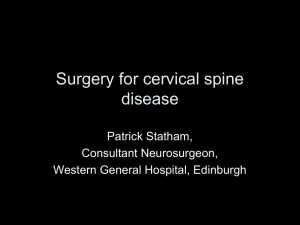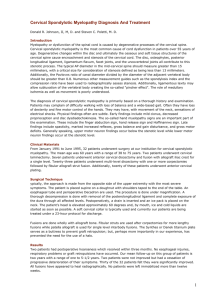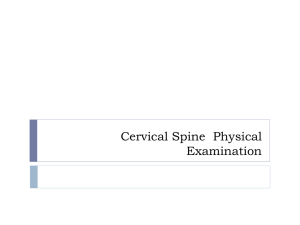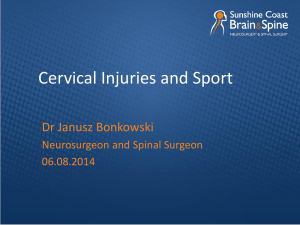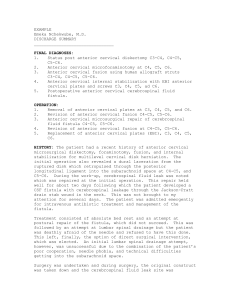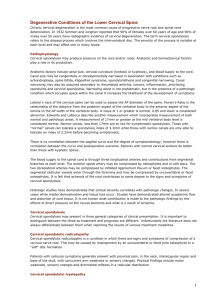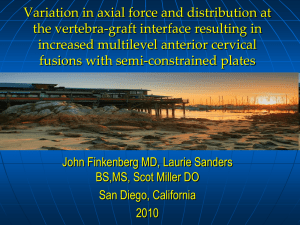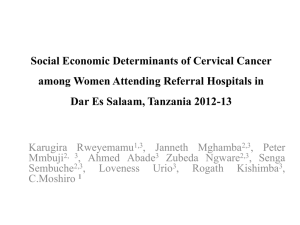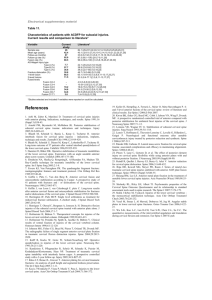Dysphagia and Vocal Cord Paralysis after Anterior Cervical Disk
advertisement
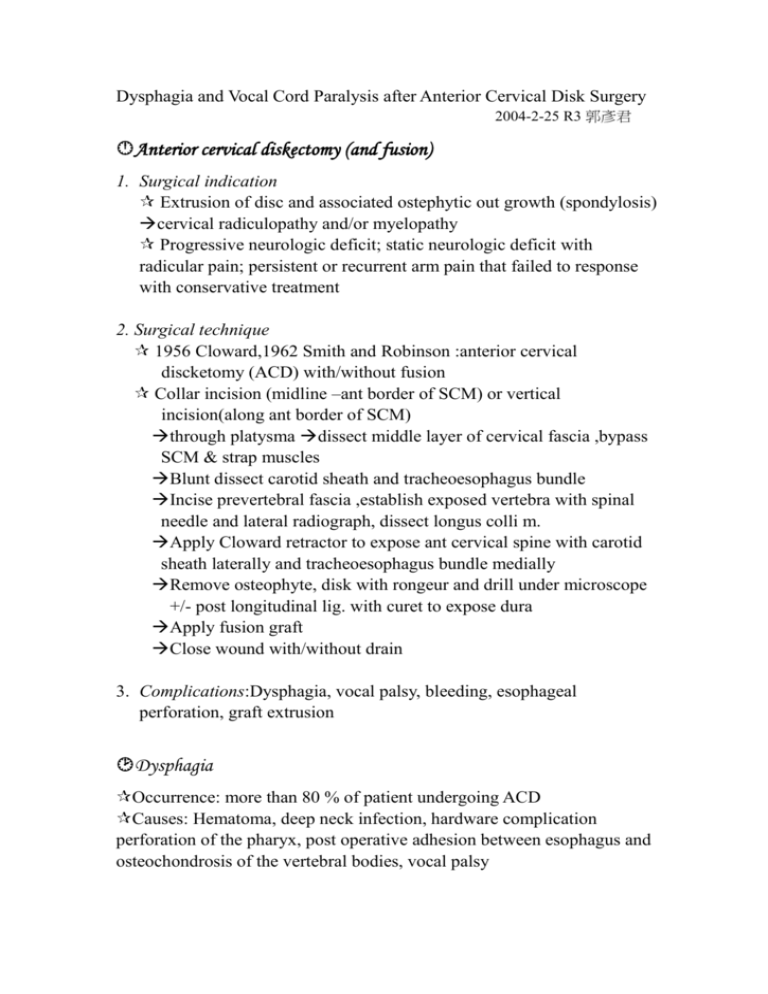
Dysphagia and Vocal Cord Paralysis after Anterior Cervical Disk Surgery 2004-2-25 R3 郭彥君 Anterior cervical diskectomy (and fusion) 1. Surgical indication Extrusion of disc and associated ostephytic out growth (spondylosis) cervical radiculopathy and/or myelopathy Progressive neurologic deficit; static neurologic deficit with radicular pain; persistent or recurrent arm pain that failed to response with conservative treatment 2. Surgical technique 1956 Cloward,1962 Smith and Robinson :anterior cervical discketomy (ACD) with/without fusion Collar incision (midline –ant border of SCM) or vertical incision(along ant border of SCM) through platysma dissect middle layer of cervical fascia ,bypass SCM & strap muscles Blunt dissect carotid sheath and tracheoesophagus bundle Incise prevertebral fascia ,establish exposed vertebra with spinal needle and lateral radiograph, dissect longus colli m. Apply Cloward retractor to expose ant cervical spine with carotid sheath laterally and tracheoesophagus bundle medially Remove osteophyte, disk with rongeur and drill under microscope +/- post longitudinal lig. with curet to expose dura Apply fusion graft Close wound with/without drain 3. Complications:Dysphagia, vocal palsy, bleeding, esophageal perforation, graft extrusion Dysphagia Occurrence: more than 80 % of patient undergoing ACD Causes: Hematoma, deep neck infection, hardware complication perforation of the pharyx, post operative adhesion between esophagus and osteochondrosis of the vertebral bodies, vocal palsy 2002 Rajesh Bazaz et al: Dysphagia decrease significantly by 6 months Female gender and multiple surgical levels as risk factors 2003 Ahmed M.S.Soliman et al: associated only with age 1997 Ruth E.Martin et al:Videofluoroscopic analysis of 13 patient— 2/13 : (1)reduced pharyngeal wall movement, (2) impaired UES opening (3) imcomplete epiglottic deflection (4) vallecular,pyriform sinus and post. Pharyngeal wall residue :prevertebral swelling 3/13 : absent pharyngeal swallow: Sup laryngeal n. injury? 4/13: oral preparatory and oral stage deficit:hypoglossal n injury compatible with operated vertebrae level Vocal cord mobility impairment Hoarsness:edema, hematoma, tearing of vocal cord, dislocation or ankylosis of an arytenoids cartilage,recurrent laryngeal n. injury Vocal cord palsy (due to recurrent laryngeal n. injury) : Incidence:0%~16% Short-term intubation injury: excessive cuff pressure in the subglottic space leading to compression of RLN between cricoid and arytenoids cartilages(1983 Sean B.pepard et al) associated with surgery duration, age During surgery: traumatic division, pinch, overstreching, post operative edema of perineural tissues, RLN included in ligation of inf. thyroid a., direct long-standing pressure by retractors,trauma to cricoarytenoid joint (Hans Heeneman et al ,1972) Which side (of approach) is better to decrease injury of RLN? Consideration of which side of approach: the side of greatest disease , RLN, comfortable, thoracic duct, esophagus The vulnerable RLN Anotomy An angle relative to sagittal plan inferiolaterally to superiomedially: R’t :25.00+/- 4.70 ; L’t : 4.70 +/- 3.70 (1996 Nabil et al) Shorter course or R’t RLN: places it at greater risk(1995 Michael J.Koriwchak et al) nonrecurrent RLN :R’t (1%) ; L’t (rare) Higher incidence of R’t RLN injury: only the study of Robinson et al Reference: 1. Schmidek & Sweet :Operative Neurosurgical Techniques 4th edition 2000 Vol II (p. 1970~1985) 2. Youmans :Neurological surgery 3rd edition 1990 (p. 2923~2935) 3. Baron EM, Soliman AM, Gaughan JP, Simpson L, Young Dysphagia, hoarseness, and unilateral true vocal fold motion impairment following anterior cervical diskectomy and fusion. Ann Otol Rhinol Laryngol. 2003 Nov;112(11):921-6. 4. Netterville JL, Koriwchak MJ, Winkle M, Courey MS, Ossoff RH.Vocal fold paralysis following the anterior approach to the cervical spine. Ann Otol Rhinol Laryngol. 1996 Feb;105(2):85-91 5. Heeneman H. Vocal cord paralysis following approaches to the anterior cervical spine Laryngoscope 1973;83:17-21 6. Weisberg NK, Spengler DM, Netterville JL. Stretch-induced nerve injury as a cause of paralysis secondary to the anterior cervical approach. Otolaryngol Head Neck Surg. 1997 Mar;116(3):317-26. 7. Beutler WJ, Sweeney CA, Connolly PJ. Recurrent laryngeal nerve injury with anterior cervical spine surgery risk with laterality of surgical approach. Spine. 2001 Jun 15;26(12):1337-42. 8. Ebraheim NA, Lu J, Skie M, Heck BE, Yeasting RA.Vulnerability of the recurrent laryngeal nerve in the anterior approach to the lower cervical spine. Spine. 1997 Nov 15;22(22):2664-7. 9. Sean B.Peppard,MD Laryngeal injury following short-term incubation Ann Otol Rhinol Laryngol 92;1983 10. Martin RE, Neary MA, Diamant NE. Dysphagia following anterior cervical spine surgery. Dysphagia. 1997 Winter;12(1):2-8; discussion 9-10. 11. Rajesh Bazaz,MD Michael J.Lee Incidence of Dysphagia after anterior cervical spine surgery Spine 27(22):2453-2458 12. Liguoro D, Vital JM, Guerin J, Senegas J. Anatomical basis of the anterior cervical spine approach: topographic study of the nerve structure. Surg Radiol Anat. 1992;14(3):203-8.
